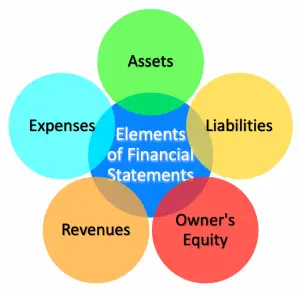Five Elements of Financial Statements
Introduction
 Five elements of financial statements provide very useful information to various users in the form of written reports that show the financial performance and condition of a company at a specific period of time.
Five elements of financial statements provide very useful information to various users in the form of written reports that show the financial performance and condition of a company at a specific period of time.
These five elements include:
- Assets
- Liabilities
- Owner’s equity
- Revenues
- Expenses
Among the five elements of financial statements, assets, liabilities and owner’s equity can be found in the balance sheet while revenues and expenses can be found in the income statement.
Five Elements of Financial Statements
Assets
Assets are the first one of the five elements of financial statements. They can be defined as the resources that the company owns in which it uses for carrying out the business activities. They either have the current value (e.g. cash) or the future value (e.g. accounts receivable).
Assets can be classified into two types, current assets, and non-current assets. Twelve months is the line between current and non-current (longer than 12 months).
They may include:
- Cash and cash equivalents
- Inventory
- Accounts receivable
- Property, plant, and equipment
| Assets | |
|---|---|
| Cash and cash equivalents | They include cash on hand, checking account, savings account, any investment that matures within three months or less, etc. |
| Inventory | Inventory may include raw materials, or goods in stock, etc. |
| Accounts receivable | The amount that customers owe the company for goods or services it has provided. |
| Property, plant and equipment | They may include land, building, car, machinery, computer, equipment, furniture, etc. |
Liabilities
Liabilities are the second one of the five elements of financial statements. They are what the company owes and has obligations to pay in the future. Like assets, liabilities can be classified into current liabilities and non-current liabilities.
They may include:
- Accounts payable
- Interest payable
- Taxes payable
- Notes payable
| Liabilities | |
|---|---|
| Accounts payable | The amount the company owes to its suppliers for goods or services it has already received. |
| Interest payable | It is the interest that the company needs to pay to its lenders or banks, usually within one year. |
| Taxes payable | Tax liabilities that the company need pay to the government, usually within one year. |
| Notes payable | Contractual obligations that the company needs to pay back to lenders or banks in the future. |
Owner’s Equity
Owner’s equity is what remains after deducting total liabilities from total assets. It is another element of financial statements that can be found in the balance sheet:
It may includes:
- Common stock
- Retained earnings
| Owner’s equity | |
|---|---|
| Common stock | The amount that the company’s owner invested in the business. |
| Retained earnings | The accumulated amount of earnings throughout the life of business which has not been attributed to the owner through dividend yet. |
Revenues
Revenues are the income that the company generates during a period of time by selling goods or providing services to the customers. Revenues are one of the five elements of financial statement which are usually found in the top line of the income statement.
The revenues that the company receives can classify into:
- Operating revenues
- Non-operating revenues
| Revenues | |
|---|---|
| Operating revenues | They are the revenues that the company receives from the main activities of the business, e.g. sale revenues. |
| Non-operating revenues | They are the money earned from side activity that is not related to the main business’s activities, e.g. interest or dividend received from investments. |
Under accrual-basis accounting, the company only records transactions in the periods in which the events occur. In this case, revenues are only recognized when the company delivers goods or provides services to the customers, regardless of when it receives cash.
Expenses
Expenses are the cost that the company incurs in running the business during a period of time. Expenses are last one of the five elements of financial statements.
They can be classified into 3 types including:
- Cost of goods sold
- Operating expenses
- Non-operating expenses
| Expenses | |
|---|---|
| Cost of goods sold | It is the cost that directly ties to the goods that the company sells. While the cost of goods sold is the cost of the purchase for a merchandising company, it may include the cost of raw material, labor, and overhead for a manufacturing company. |
| Operating expenses | They are the expenses that incur in operating of the business but are not related to the cost of goods sold. They may include selling expenses and general and administrative expenses. |
| Non-operating expenses | They are the expenses that not related to the operating of the business, e.g. interest expenses or loss on disposal of the fixed assets. |
Under the accrual basis, the company recognizes expenses when they incur regardless of when the money is paid.